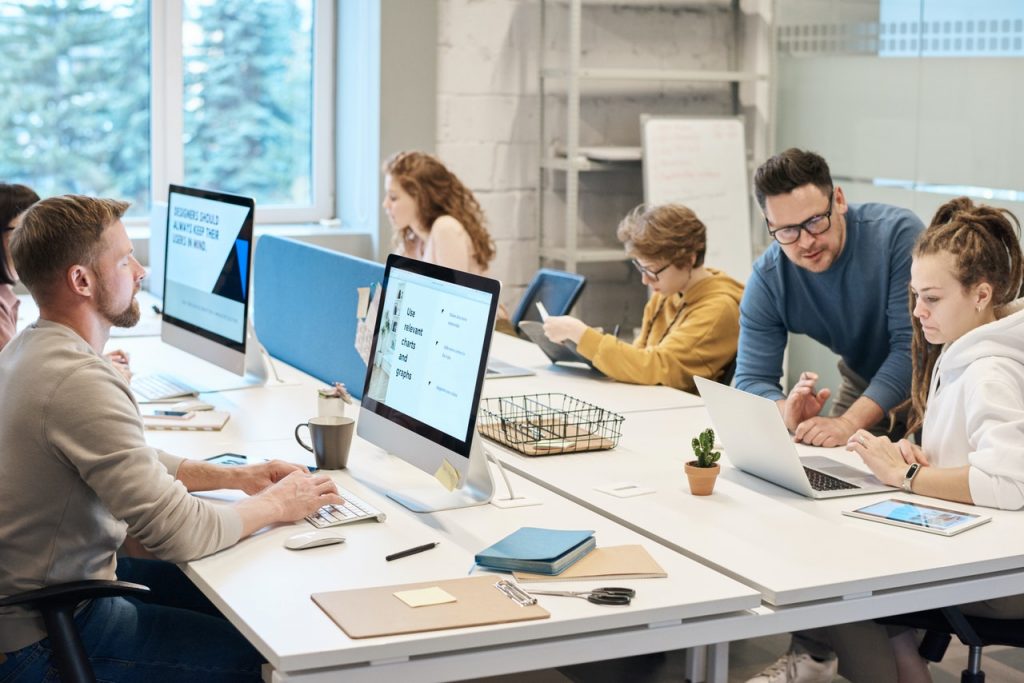Workplace productivity and efficiency have a lot to do with design. Unlike the decades that preceded office modernization, employees no longer work best in rigid layouts with sky-high cubicles and fluorescent overhead lighting. Today, offices are designed with productivity and efficiency in mind, making way for modern workplaces that are conducive to better employee motivation and satisfaction, which ultimately leads to the growth and success of a business.
Here are the best ways to design an office for maximum productivity.
1. Make an efficient layout
Create an office layout wherein people can get to where they need to go in the fastest way possible. This can mean segmenting departments in such a way that they are ‘separate’ but not entirely cut off from each other, optimizing the pathways to bathrooms and the pantry, and eliminating ‘mazes’ that make it difficult for employees to move around efficiently.
2. Improve lighting
Lighting is a crucial element in office design. Poor lighting can lead to eye strain, fatigue, stress, and headaches, among other physical and mental issues. As a result, employee productivity, efficiency, and motivation decrease.
The best type of lighting for any workplace is natural light. Increase the amount of natural light that comes into the office by opening up windows (and cleaning them), as well as removing any obstructions that block natural light from coming in. At the same time, install indirect lighting in the form of high-quality LED panel lights to increase illumination in the office without it being too harsh on employees’ eyes, unlike fluorescent lights.
3. Invest in ergonomic furniture
One of the worst killers of productivity and motivation is body pain, which is mostly caused by poor posture. Since employees are sitting for most of the day, they need furniture that promotes proper posture to reduce pain, particularly in the lower back, neck, and head.
Invest in ergonomic furniture that is designed with functionality and comfort in mind. Ergonomic chairs, unlike regular office chairs, provide proper lumbar support that helps maintain proper posture and avoid back pain. Adjustable tables, on the other hand, helps ensure that tables are at the right height for employees, regardless of their height and torso length.
4. Raise the ceilings
A higher ceiling height allows employees to think more freely, making way for more creativity and light bulb moments.

5. Choose the right colours
Colour can affect people’s feelings and perceptions, which makes colour an incredibly important factor in office design. The best type of colour scheme for an office depends on the type of work being done, for instance:
Light blue.
This colour is best for employees that need to focus on repetitive tasks, as in accounting departments. It promotes orderliness, reduces mental strain, and helps clear people’s thoughts.
Yellow.
Dashes of yellow in an area can help employees retain information, as yellow is known to help boost memory. That said, putting yellow accents in training and meeting rooms is a great way to help employees absorb information better.
Red.
The colour red is ideal for employees that need to do a lot of physical activity or have to be mentally alert. It is best used as furnishings and accents than wall colours.
Green.
Green is one of the best colours to have in an office where employees usually work long hours and require lots of concentration throughout the day. This colour is easiest on the eyes, which can make employees less tired and more productive.
Orange.
An office can look more fun and inviting with touches of orange. However, this colour should not be used in excess to avoid being distracting and thus counterintuitive to the goal of making a productive office.
6. De-clutter
Remove unnecessary furniture and office equipment. Keep supplies out of sight. Encourage employees to minimize the clutter on their own desks. Clutter can create disorder in our minds, increasing cognitive overload and making it difficult to focus and remember things. That said, reducing clutter in the office is one of the best ways to boost productivity and reduce mental stress.
7. Have a collaboration room
Provide a space for employees to come and work together without disturbing other departments or compromising their team’s privacy. Create an enticing conference room with comfortable furniture, stimulating decor, and adequate technology that will make meetings go faster and easier.
It doesn’t matter how many pizza parties are held every Friday or how swanky the office tech is–if an office is not designed with productivity in mind, it will most likely not be conducive for it.
There are many ways to increase office productivity through design; these are just some of the most basic yet most important ones to keep in mind.



